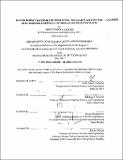Water borne transport of high level nuclear waste in very deep borehole disposal of high level nuclear waste
Author(s)
Cabeche, Dion Tunick
DownloadFull printable version (3.457Mb)
Other Contributors
Massachusetts Institute of Technology. Dept. of Nuclear Science and Engineering.
Advisor
Michael J. Driscoll.
Terms of use
Metadata
Show full item recordAbstract
The purpose of this report is to examine the feasibility of the very deep borehole experiment and to determine if it is a reasonable method of storing high level nuclear waste for an extended period of time. The objective of this thesis is to determine the escape mechanisms of radionuclides and to determine if naturally occurring salinity gradients could counteract this phenomenon. Because of the large dependence on the water density, the relationship between water density and the salinity was measured and agreed with the literature values with a less than 1% difference. The resultant relationship between the density and salinity is a linear relationship with the molality, and dependent upon the number of ions of the dissolved salt (e.g. CaCl₂ contains 3 and NaCl has 2). From the data, it was calculated that within a borehole with a host rock porosity of 10-⁵ Darcy, it would take approximately 10⁵ years for the radionuclides to escape. As the rock porosity decreases, the escape time scale increases, and the escape fraction decreases exponentially. Due to the conservative nature of the calculations, the actual escape timescale would be closer to 106 years and dominated by 1-129 in a reducing atmosphere. The expected borehole salinity values can offset the buoyancy effect due to a 50°C temperature increase.
Description
Thesis (S.B.)--Massachusetts Institute of Technology, Dept. of Nuclear Science and Engineering, 2011. Cataloged from PDF version of thesis. Includes bibliographical references (p. 52).
Date issued
2011Department
Massachusetts Institute of Technology. Department of Nuclear Science and EngineeringPublisher
Massachusetts Institute of Technology
Keywords
Nuclear Science and Engineering.